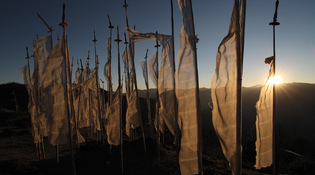 loading
loading
featuresNation of the forestIf Bhutan succeeds in preserving its extraordinary natural heritage, it will be because of Buddhism. But Bhutanese Yale alumni can take some credit.  Yeshey DorjiIn the mountains above Paro, white prayer flags honor the dead. View full image
Prayer flags for the dead never posed a problem in Bhutan until people began moving to cities. In the Tibetan Buddhism practiced here, mourners honor the dead by flying 108 white flags, each attached to a tall wooden pole. They plant the poles on high ridges where, they believe, the wind will broadcast the prayers and mantras printed on the flags, enhancing the well-being of all living creatures. But now that a third of Bhutanese are concentrated in cities, deaths are concentrated there too. The need to cut thousands of trees for flagpoles year after year threatens to denude the surrounding hillsides. In the early 1960s, when Sangay Wangchuk ’93MF was a small boy, few Bhutanese could afford enough cloth for 108 flags. His parents were subsistence farmers with little cash, and the climate was too cool for growing cotton. Once a year, they walked to India to buy essentials like cloth and salt. The trip took seven days, and whatever they brought back, they had to carry. Nowadays, people have enough cash to buy flags and easy access to them, says Sangay Wangchuk, who directs the Forestry Centre for the South Asian Association for Regional Cooperation. (Like most Bhutanese, he uses a two-part first name and no family name.) “Suddenly,” he says, “everything is available.” Western-style consumption has come only recently to Bhutan, where tourists were not admitted until 1974 and television and the Internet were prohibited until 1999. Today, the government is actively trying to reduce poverty by promoting economic development. In Thimphu, the capital (and, with a population of more than 80,000, the largest city by far), the stores lining the commercial streets stacked on the hillside sell DVDs, computers, construction materials, imitation North Face jackets, and, for tourists, silver bracelets and scrolls painted with deities. Specialty shops catering to monks sell robes, sunhats, and fleece jackets, all in the maroon-and-gold palette of Tibetan Buddhism. They also sell prayer flags. To spare the trees, since 2006 forest department rules have limited mourners to 29 poles and designated which trees can be cut. The traditional number of 108 is sacred, but Sangay Wangchuk says city dwellers have actually welcomed the restriction. “It’s like any other city—there are so many things to attend to. Now when they’re told, ‘We can give you only 29,’ they say, ‘Fine.’” Dwindling pine groves are the kind of problem posed by economic growth in any developing, or developed, country. But two things make Bhutan singular: first, its royal family has promoted an ethic of conservation, what the Bhutanese call “the vision of our kings.” Second, the Bhutanese have formulated guidelines, infused with Buddhist values, for how to reconcile old and new, prayer flags and cities, so as to raise their standard of living while conserving their culture and environment. A small group of Yale alumni—Sangay Wangchuk and a dozen others who have studied forestry or environmental management at Yale since the early 1990s—are among the elite whose efforts will help to determine whether Bhutan can pull this off.
|
|